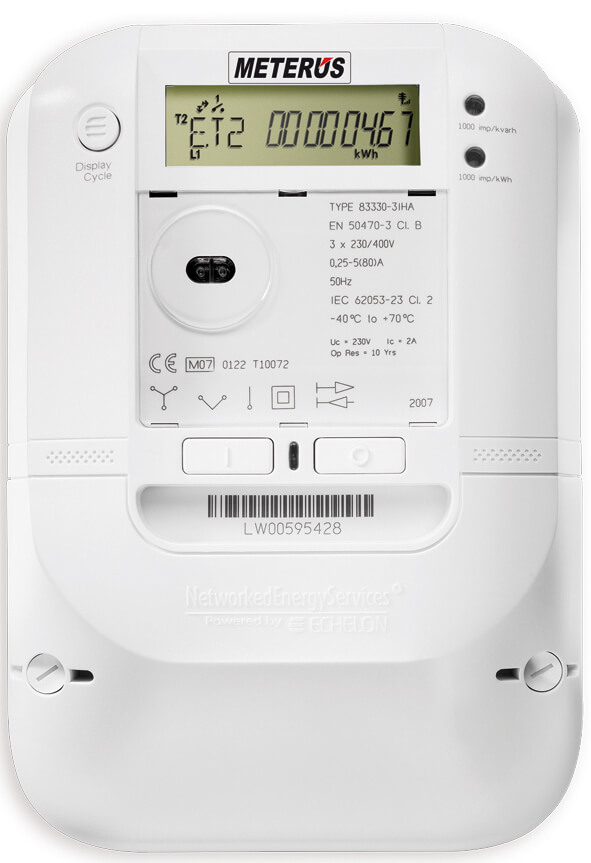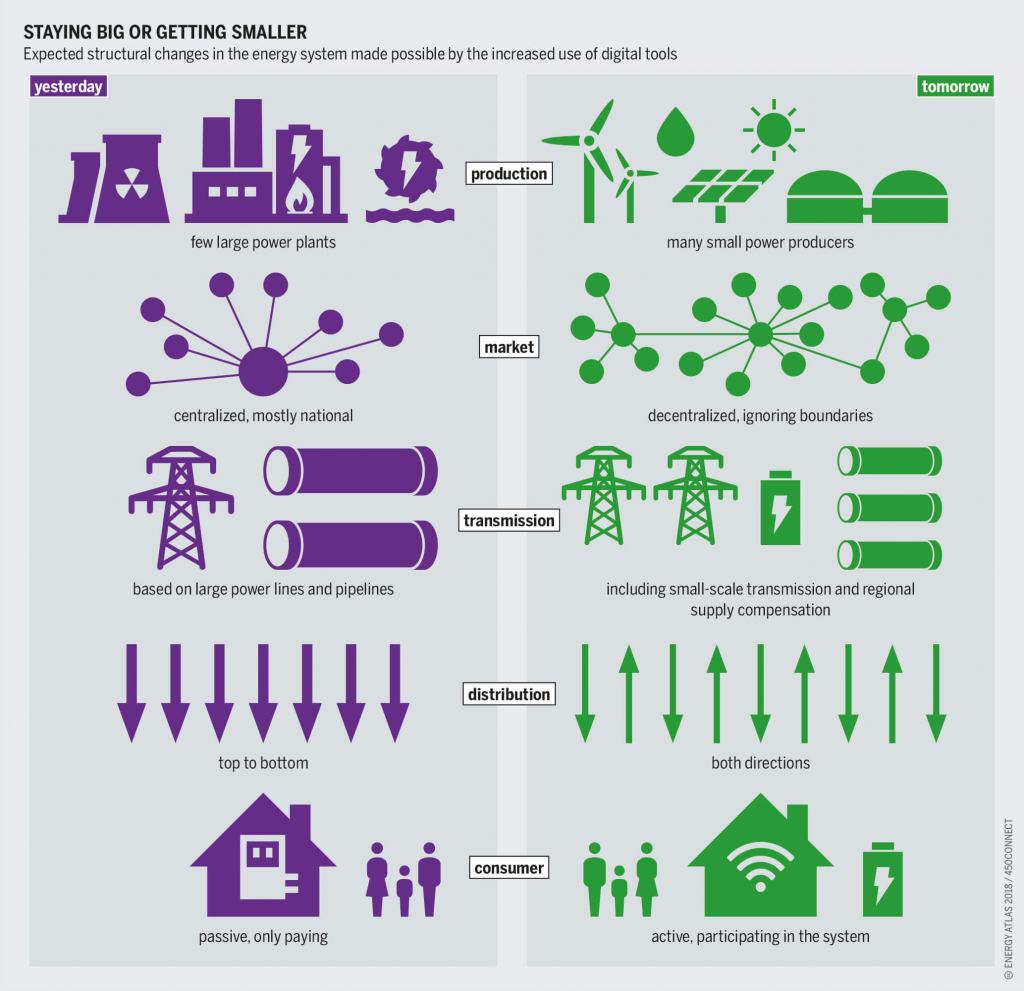Internet of Things in energy sector: definition, uses, challenges

While the principles of IoT are similar no matter what industry, the precise application may be obscure in different sectors. It isn’t always clear how to convert the basic benefits of digitization, automation, energy load management, data collection, and data analytics into measurable profit. Let’s consider several examples of how IoT is transforming the energy industry.
What is the IoT in energy?
The Internet of Things in energy sector refers to the technology that connects energy production, energy distribution, and energy consumption into a united system to help manage demand-response more efficiently. IoT in energy is implemented to improve energy efficiency and enhance the reliability and sustainability of energy networks.
Why does IoT in the energy sector matter?
The energy industry faces growing demand from many industries, including the information and communication technologies industry, transportation, air conditioning, home appliances, and more. The Internet of Energy helps utilities monitor and manage power grids during extreme events, such as severe weather or natural disasters.
Another aspect is the widespread usage of renewable energy sources. The energy industry faces challenges due to the intermittent nature of renewables, but the Internet of Things provides security by enabling forecasting and predictive maintenance.
IoT can become a link to connect conventional power grids and renewable energy generation. By optimizing energy usage and integrating renewables, IoT can help reduce carbon emissions from energy production.
5 uses of Internet of Things in energy sector
1. Smart metering
A good illustration of using IoT in the energy industry is smart metering. Smart electric meters are IoT-enabled devices that collect advanced information about energy usage. Unlike conventional meters which can only show the amount of energy consumed, the data collected by smart meters include voltage level, current, and power factor. This data helps energy suppliers have a more accurate image of the actual energy demand and energy consumption patterns.
Smart metering systems can communicate with the power supplier systems and automatically send there the collected data. By analyzing the smart metering data, the utility companies can tailor the energy supply to the actual demand. This way the power plants can avoid energy waste caused by overprovision and prevent electricity shortages resulting in cutting off some households’ electricity.
Smart metering technology has two-sided benefits for energy saving. On the one side, smart meters give consumers a deeper understanding of how much electricity they use and how much money they spend on this. Smart meters can also show the current price for electricity. This way, users can detect loopholes and find the most optimal way to stay energy efficient and save costs.
On the other side, energy companies get more accurate information about consumption patterns and receive the information automatically, without user interaction. Understanding the energy consumption patterns is important because the stable energy flow relies on a strict balance between production and consumption.

2. Smart grids
A smart grid is a new generation of energy grid that is more technologically advanced. While conventional power grids are mostly electromechanical, smart grids are designed to use digital technologies by default which opens up new possibilities.
Sensors and controllers installed in smart grids make it possible to identify, localize faults, and “recover” faster. For instance, the conventional grid relies significantly on manual work to find out flaws. This means that the control centers see when and where something goes wrong, but the technician needs to come and check manually whether it’s a cable issue or something else.
IoT applications in smart energy grids can detect faults themselves. The IoT energy monitoring solutions allow smart grids to reconfigure the energy flow bypassing the affected parts and resupplying power without human involvement.
Smart grids tend to use a microgrid structure. Such a configuration implies that the grid delivers electricity to small communities, but is connected to a larger energy network. When something goes wrong within a microgrid, it is shut off locally and the blackout stays within the small area, without affecting other consumers.
The smart grid illustrates the importance and value of IoT in renewable energy: a possibility of bi-directional electricity and data flow. IoT solutions allow users with solar panels to supply sustainable electricity to their homes and minimize the consumption of electricity generated from burning fossil fuels. Furthermore, if there’s excess solar power, users can sell it back to the grid.
While smart grids are on the rise, their mass implementation still represents a challenge. The main difficulty is how to make all the sensors, controllers, meters, and digital technologies work together and normalize the received data. To create a high-quality and safe energy management system, look for an IoT development company with proven experience in the domain.

3. IoT energy monitoring & automation of energy usage
How to monitor energy usage with IoT? IoT-based home automation and smart metering technologies make this possible. A prime example is an IoT energy management solution Vakoms has been working on. The software is aimed at automating energy consumption intelligently helping households avoid excessive energy usage during high demand.
Consuming electricity during high demand is bad for two reasons. First, there’s a risk of being cut off from electricity completely until the energy utility retrieves the balance between supply and demand. Second, the rate during high demand is significantly elevated. Avoiding excessive consumption during high demand is a good way of optimizing energy usage and saving costs.
The plugin we’re working on allows automating the routines for smart devices. For instance, users can add a scenario where the plugin will automatically turn off a fan or another device during high demand, and turn it back on when the high demand event is over. This way, users can create a fully automatic environment that will save energy without human interference.
Additionally, the software works perfectly with smart meters, allowing users to forget about manual transferring of the metering data. The plugin can communicate directly with the electricity provider, collecting and sending the meter readings at any moment when required.
4. Prediction of accidents and condition monitoring
IoT helps monitor the condition of the electric grid and prevent possible accidents. Natural disasters and supply-demand imbalances can cause severe damage to power plants and result in major blackouts.
IoT sensors in the grid can monitor the condition of its parts and alert about possible issues before they happen. If the grid is “smart”, it already has its prediction and “self-healing” mechanisms in place. If a line goes down, the self-healing mechanisms allow bypassing the damaged nodes and re-energizing of unaffected parts of the grid.
Conventional grids can also benefit from IoT applications in the energy sector. Smart sensors and predictive technologies can monitor and analyze energy consumption and grid conditions. IoT allows for more accurate communication between power stations, vital nodes of the network, and the grid.
Algorithmic and data-driven processes can analyze the collected data and create prediction models to forecast natural disasters or potential accidents. The prediction models help us stay informed about upcoming issues and respond to them properly. This improves the sustainability of the energy sector.
Having the proper prediction models in place, it’s possible to manage consumption patterns to avoid heavier consequences like major blackouts. If consumers get notified about a possible disaster, they can minimize the electricity usage and reduce the load on potentially vulnerable nodes which will also contribute to the higher sustainability of the grid.
5. Improved energy efficiency in the manufacturing sector
The industrial sector consumes a significant amount of the produced electricity. Implementing IoT solutions for industries is one of the ways to stay energy efficient and improve the sustainability of the manufacturing sector.
How can IoT save energy in manufacturing? IoT energy monitoring systems help manufacturers optimize energy consumption and reduce costs. Smart systems that can monitor energy consumption in real time help manufacturers get more accurate information about their energy usage and optimize it where possible.
Hardware like sensors and actuators collects real-time data from the essential manufacturing nodes. It can detect unnecessary energy consumption, productivity issues, equipment left on, and other inefficiencies. For instance, overheating of the equipment can indicate either energy waste or impairment in the machine. Both issues can be recognized by smart IoT solutions and rectified before the damage is done.
IoT sensors send the collected data to the dashboard, it is then analyzed and transformed into usable information. The sorted data gives insights into what can be improved to reduce energy consumption and expenses. Clear and more accurate data about electricity usage also promotes responsible consumption among the manufacturers.
5 challenges of IoT in the energy sector
The integration of IoT devices into the energy system poses a significant challenge due to its complexity. Let’s review some of the most common challenges.
1. Security and privacy concerns
Security is a huge concern for energy producers. IoT devices in the energy sector can be targeted by cyber attacks, including hacking, malware, and DDoS attacks that can disrupt the functioning of critical infrastructure, leading to power outages. Any security breach can put at risk the entire system and leave hundreds of households without a power supply. IoT in energy sector must be particularly secure and reliable to provide stable work.
Data privacy is another challenge for power suppliers and a concern for customers. IoT devices collect vast amounts of data, including personal and usage information. Without proper safeguards, this data can be used to track and profile individuals, infringing on their privacy.
2. Integration
Integrating IoT in power sector is quite challenging due to the high number of older grids and technologies that weren’t meant to work with IoT devices. To modernize such grids, it may be necessary to redesign the entire architecture and replace old components with new ones. This task becomes a huge challenge since the grid has to work non-stop.
Another concern is integrating renewable energy sources into the stable system of the power generation utilities. Renewable energy is intermittent and if integrated improperly can disrupt the existing demand-response balance of the conventional grid.
3. Data management and analytics
IoT devices generate massive amounts of data continuously. It’s not enough to store the data securely: it must be processed, analyzed, and presented understandably to be useful. Energy systems are inherently complex, with numerous variables and interdependencies.
Analyzing such systems requires advanced analytical techniques and domain expertise. Dealing with huge amounts of data requires a lot of storage, robust data management systems, strong database capabilities, and wise data processing algorithms. In addition, it also requires specialized knowledge to work with the data.
4. Regulatory and compliance issues
Regulatory bodies often set standards for grid reliability and performance. Internet of Things and energy systems must ensure compliance with these standards to maintain grid stability and avoid penalties. Making a uniform and compliant system is time-consuming and resource-intensive. It involves a lot of organizational issues and technical difficulties.
Obligatory regulations include technical standards, data privacy and protection, security protocols, operational compliance, mitigation strategies, legal frameworks, and more. As IoT technologies become more global, companies must also consider international regulations and standards, which may differ significantly from domestic ones.
5. Cost
Solutions to all the challenges and issues are coupled with huge investments. If we are talking about the modernization of the existing power systems, every step from hardware sensors to software updates has to be paid for.
The expenditures include the cost of hardware — sensors, actuators, and devices; installation, deployment, and maintenance costs; costs for developing and maintaining software for managing the system, and more. Smart energy is an industry that needs to be invested in and will pay off at the end of the day, yet it’s not likely to be an easy walk so far.
Final thoughts on IoT for energy
IoT for energy is a scalable and flexible technology that can be useful for any company looking for digitization, automation, or optimization of its processes. IoT energy monitoring, solar power IoT solutions, and other IoT applications in energy sector opened up many possibilities to companies and smart homes looking for ways to achieve sustainability and energy efficiency. If you need tech advice on benefiting from IoT, don’t hesitate to ask our specialist.
FAQ
What are the main benefits of implementing IoT in the energy sector?
Implementing IoT in the energy sector enhances the operational efficiency, reliability, and sustainability of energy systems. It also helps integrate renewable energy sources, ensure better supply-demand response, and use energy more efficiently.
How does IoT contribute to energy conservation and sustainability?
IoT optimizes energy consumption through real-time monitoring and analytics, reducing waste and improving efficiency. It also facilitates the integration and management of renewable energy sources, promoting cleaner and more sustainable energy practices.
How can IoT affect the operational costs in the energy sector?
IoT enables predictive maintenance to minimize equipment downtime, which lowers repair and replacement expenses. Real-time monitoring and optimization of energy usage help reduce energy waste and cut overall consumption costs.




